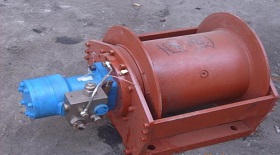Radial plunger type hydraulic motor
Working principle of radial plunger type hydraulic motor is when the pressure oil enters the bottom of cylinder internal plunger through the window of fixed oil distribution shaft 4, the plunger extends outwards and firmly supports the inner wall of stator, because there is an eccentric distance between stator and cylinder. At the contact point between the plunger and the stator, the stator's reaction force on the plunger. The force can be decomposed into two components. When the oil pressure acting on the bottom of the plunger is p, the plunger diameter is d, and the Angle between the force and the plunger is X, the force produces a torque on the cylinder to make it rotate. The cylinder is connected through the end of the driving shaft outward output torque and speed.
In the case, where the torque is generated by a plunger analyzed above, there are several plunges acting on the oil pressure area. The torque generated on these plunges rotates the cylinder and outputs the torque. The radial piston hydraulic motor is mainly used for low speed and high torque.



